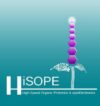Scientific background
Carbon-based semiconductors are attractive because carbon is widespread as a raw material and thus they are now used across the world in OLED displays. OSCs have many attractive features including simple deposition by evaporation or from solution, leading to devices with lower energy of manufacture. They can be deposited onto a huge range of substrates, including biodegradable substrates such as silk fibroin or cellulose . In addition, as epitaxy is not required, different materials can be deposited side by side, greatly simplifying manufacture – this is the reason that organic, not inorganic LEDs are used for mobile phone displays.
OSC lifetimes are sometimes up to 1,000,000 hours, corresponding to decennial guaranteed operation [3]. In spite of all these attractive properties, OSCs are generally considered to be slow because of their very low mobilities compared to their inorganic counterparts (often ~10-5 cm2/Vs), because they are not crystalline. So whilst this is an advantage for their synthesis and fabrication, it is believed to severely constrain their performance.
This is why, until very recently, OLEDs have been considered as slow devices with turn-on time in the order of a few ms, just fast enough for video fluidity of displays. The HiSOPE breakthrough lies in the fact that contrary to common thinking, OLEDs show high-speed properties very suitable for optical communication (OC) as demonstrated by USTAN, USPN an CEA-LETI very recently [4, 5, 6]. It is noteworthy that the fast response capability of OSCs was already predicted in 1992 by the Nobel Prize winner A. Heeger [7].









